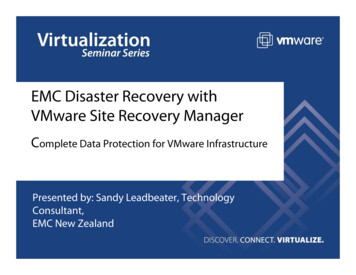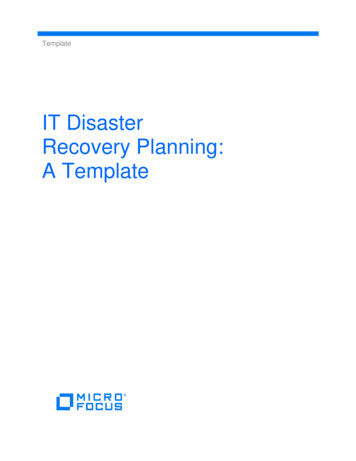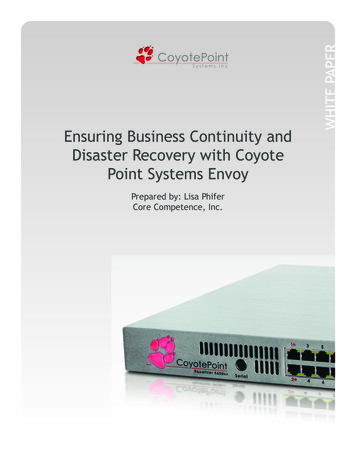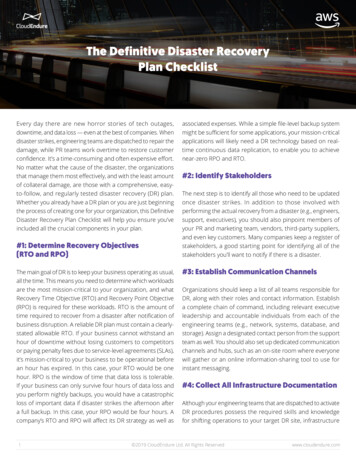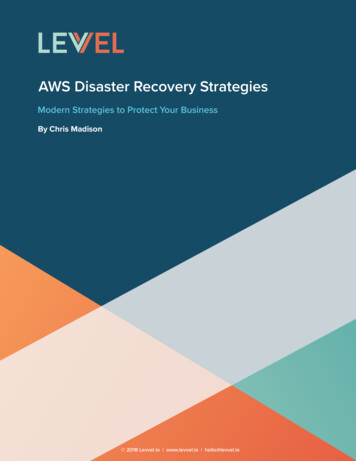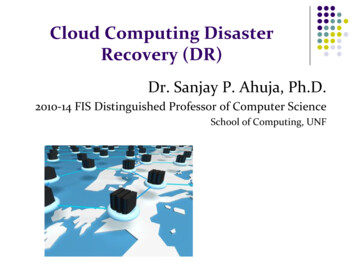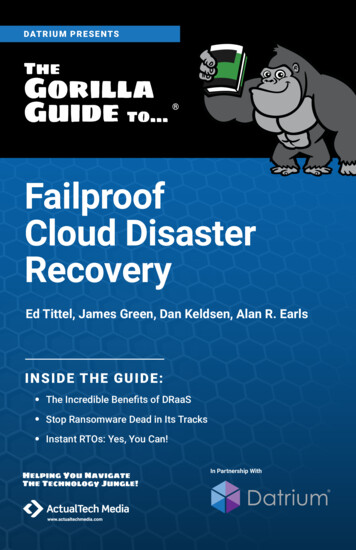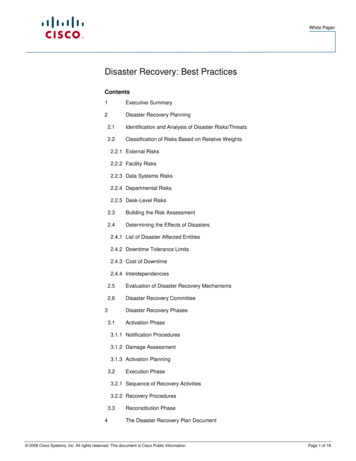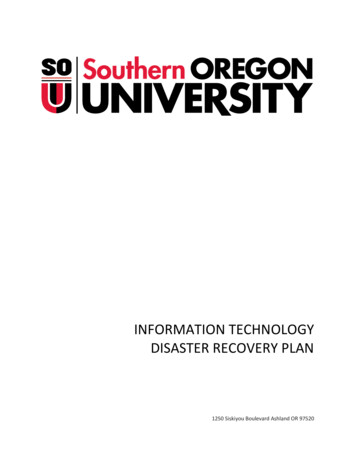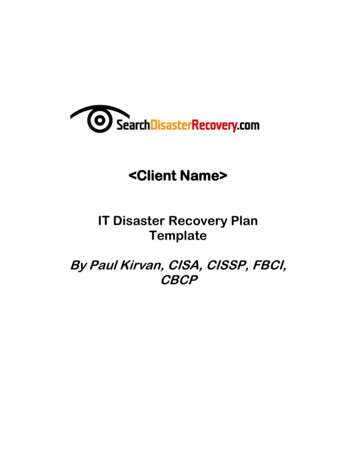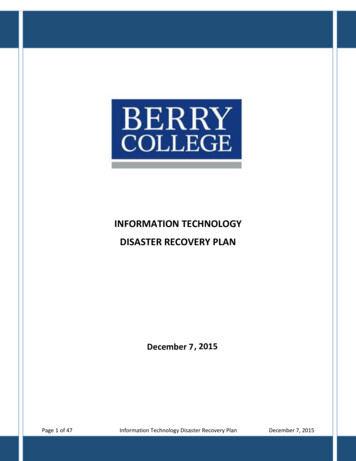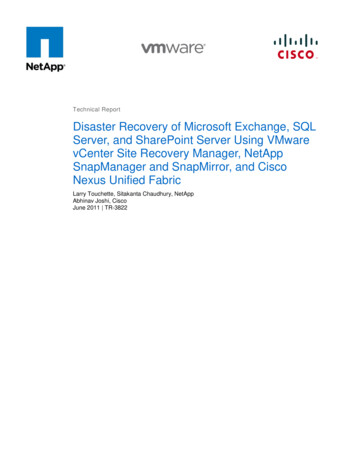
Transcription
Technical ReportDisaster Recovery of Microsoft Exchange, SQLServer, and SharePoint Server Using VMwarevCenter Site Recovery Manager, NetAppSnapManager and SnapMirror, and CiscoNexus Unified FabricLarry Touchette, Sitakanta Chaudhury, NetAppAbhinav Joshi, CiscoJune 2011 TR-3822
TABLE OF CONTENTS1INTRODUCTION . 42SOLUTION SUMMARY. 53SOLUTION DESIGN . 843.1HIGH-LEVEL SOLUTION ARCHITECTURE . 83.2SOLUTION COMPONENTS . 93.3ACTIVE DIRECTORY/DNS SOLUTION ARCHITECTURE . 103.4MANAGING IP ADDRESS CHANGES BETWEEN SITES. 113.5DR FAILOVER RECOVERY TIME OBJECTIVE . 123.6NETWORK ARCHITECTURE . 133.7STORAGE ARCHITECTURE . 153.8NETAPP SNAPMIRROR REPLICATION ARCHITECTURE . 163.9SRM CONFIGURATION . 183.10NETAPP VSC RECOVERY CONSIDERATIONS . 20SOLUTION VALIDATION . 204.1SRM DR TEST PROCESS . 204.2SRM FAILOVER PROCESS . 224.3SRM FAILBACK PROCESS . 245SUMMARY . 256ACKNOWLEDGEMENTS . 267REFERENCES . 268FEEDBACK . 278.1 APPENDIX: VCENTER RIGHTS REQUIRED FOR THE SNAPDRIVE ACCOUNT . 27REVISION HISTORY . 27LIST OF TABLESTable 1) Microsoft application virtual machines. . 6Table 2) Software components. . 9Table 3) SRM protection groups and recovery plans. . 18Table 4) DR test results. . 21Table 5) Failover test results. . 23LIST OF FIGURESFigure 1) NetApp Multistore with vFiler units. . 5Figure 2) SnapManager recovery points. . 7Figure 3) Typical storage requirement for DR testing. . 72Disaster Recovery of Microsoft Apps using VMware vCenter Site Recovery Manager, NetApp, and Cisco
Figure 4) High-level solution architecture. . 9Figure 5) Seizing FSMO roles. . 11Figure 6) Ethernet solution network architecture. . 13Figure 7) Recovery site ESXi host network diagram for Ethernet architecture (iSCSI, NFS). . 14Figure 8) FC Solution network architecture. . 15Figure 9) Virtual machine datastore layout. . 16Figure 10) High-level replication architecture. . 17Figure 11) Recovery plan VM startup priority. . 18Figure 12) SnapDrive communication before and after SRM failover. . 19Figure 13) DR test summary steps. . 20Figure 14) DR test mode. 21Figure 15) Failover summary steps. . 22Figure 16) SnapManager recovery timeline. . 23Figure 17) Failback summary steps. . 243Disaster Recovery of Microsoft Apps using VMware vCenter Site Recovery Manager, NetApp, and Cisco
1 INTRODUCTIONAs customers move toward their goal of having 100% virtualized data centers, they increasingly look for ways to bring the benefits of VMware virtualization to their mission-critical Microsoft applications.Customers planning a new deployment, performing an upgrade, or planning to virtualize 100% of their data center have an ideal opportunity to make the transition to a VMware vSphere virtual infrastructure built on NetApp unified storage.Virtualizing Microsoft applications on NetApp unified storage provides enhanced data protection and fullyautomated disaster recovery capabilities. Typically, a virtualized Microsoft application provides muchgreater flexibility and complete automation with predefined disaster recovery (DR) processes and easier,streamlined recovery in the event of a disaster.This solution guide describes the architecture and validation of recovery of Microsoft applications withVMware vCenter Site Recovery Manager (SRM) in the NetApp environment. For detailed informationon SRM, refer to TR-3671: VMware vCenter Site Recovery Manager in a NetApp Environment.Some key benefits of the overall solution are: Reduced disaster recovery (DR) costs with SRM. SRM decreases the risks associated withtraditional DR. Repeatable, reliable DR processes are easily developed and maintained. Recoverytime objective (RTO) durations are improved through the use of DR workflow automation features. Inaddition, SRM provides a valuable DR testing capability that allows you to quickly and nondisruptivelyperform DR tests. Maintaining identical physical hardware at both locations is not required; otherprocesses such as testing and development are enabled to make use of the equipment at the DRsite. Reduced infrastructure costs with NetApp storage solutions. NetApp’s disaster recovery solutionhelps reduce cost so that the savings achieved at the primary site can be used to fund the DR site.With the NetApp solution, you can achieve multiple levels of storage efficiency at the primary site, andthe savings are preserved at the DR site. Built-in WAN acceleration strongly complements thisbecause it reduces the amount of WAN bandwidth required for site-to-site replication transfers bymore than 80%. NetApp technologies eliminate the need to maintain twice the disk space at the DRsite if you want to perform DR testing without interrupting the site-to-site replication. The key NetApp technologies that enable this are thin provisioning, deduplication, NetApp FlexClone , and NetApp SnapMirror compression. Application-consistent disaster recovery. NetApp provides the capability to recover applications in a consistent state after failover to the DR site. The NetApp application-specific SnapManagerproducts along with SRM offer the ability to maintain a history of multiple, verified, applicationconsistent recovery points at the DR site. The NetApp SnapManager solution is built using integratedVMware, Microsoft, and NetApp technologies for advanced, application-aware data protection. Simplified disaster recovery processes. DR workflow automation provided by SRM and theNetApp Storage Recovery Adapter allow the customer to implement testable, repeatable, and, mostimportantly, reliable disaster recovery processes. Flexible and secure multi-tenancy (SMT). NetApp unified storage with MultiStore capability offersend-to-end data security, nondisruptive data mobility, load balancing across storage controllers, andbetter manageability in a multi-tenant cloud environment. NetApp MultiStore divides a single storagesystem into multiple secure partitions called vFiler units. Individual vFiler units can be assigned toseparate “tenants,” which can be individual organizations, departments within an organization, orindividual applications. The vFiler units can also be shared by multiple organizations depending onthe requirements. For more details on the NetApp SMT solution, refer -tenancy.html.4 Disaster Recovery of Microsoft Apps using VMware vCenter Site Recovery Manager, NetApp, and Cisco
Figure 1) NetApp Multistore with vFiler units.The unique design of MultiStore allows it to support NetApp Data Motion for nondisruptive migration oftenant data between storage systems. With NetApp Data Motion, an entire vFiler unit can be migratedfrom one storage system to another without disrupting ongoing tenant activity. NetApp Data Motion does for data what VMware VMotion does for virtual machines (VMs), making it simple to migrate data at alarge scale. Combining these services with NetApp Data Motion provides mobility at every layer of yourvSphere infrastructure for load balancing, nondisruptive upgrades, or to satisfy other data center needs.For detailed information on MultiStore, refer to tsecure-mobile-cloud-storage-1001.html.2 SOLUTION SUMMARYThis solution guide offers guidance on the design and validation of the SRM and NetApp solution fordisaster recovery of the Microsoft applications mixed workload similar to the workload described in TR3785: Microsoft Exchange Server, SQL Server, and SharePoint Server Mixed Workload on VMwarevSphere 4, NetApp Unified Storage (FC, iSCSI, and NFS), and Cisco Nexus Unified Fabric. In addition to the recovery of the Microsoft Exchange, SQL Server , and SharePoint environments, this guide also describes processes for providing the Microsoft Active Directory and Domain Name System(DNS) services on which the applications are highly dependent.SRM features such as DR testing, DR failover, and DR workflow automation of Microsoft applicationshave been successfully validated.In this solution guide, the virtualized Microsoft applications are protected and recovered by SRM, NetAppSnapMirror, and application-specific SnapManager products.To verify the validity of this solution design in SMT environments, the processes were validated on bothNetApp physical arrays and with Microsoft applications data stored in MultiStore vFiler units. ForMultiStore validation, each application was hosted on a different vFiler unit with a corresponding vFilerunit on the SRM recovery site.Table 1 provides the details of the application VMs tested in this solution.5Disaster Recovery of Microsoft Apps using VMware vCenter Site Recovery Manager, NetApp, and Cisco
Table 1) Microsoft application virtual machines.Microsoft ApplicationMicrosoft Exchange Server 2010Microsoft SQL Server 2008 R2Microsoft SharePoint Server 2010Microsoft Active Directory and DNS ServicesVirtual MachineTwo Exchange mailbox serversTwo Exchange CAS servers, two hub serversTwo SQL ServersTwo Web/query serversOne index server, one SQL ServerTwo AD/DNS servers at protected site and one at recovery siteThe key highlights of this solution are: Microsoft applications virtualization with VMware vSphere 4 Microsoft applications DR with SRM and application consistency with NetApp SnapManager andSnapMirror products Integrated, storage-efficient DR testing with NetApp FlexClone Storage efficiency, without any negative trade-offs, with NetApp primary storage deduplication,FlexClone, and thin provisioning Efficient WAN acceleration with deduplication-aware built into NetApp SnapMirror compression Solution supportability for SMT environments using NetApp MultiStore vFiler units with Data MotionNETAPP SNAPMANAGER RECOVERY POINTSNetApp SnapManager for SQL Server, SnapManager for Exchange, and SnapManager for SharePointprovide flexible DR options by allowing the creation and verification of a history of multiple recovery pointsthat are replicated to the recovery site. The SnapManager applications create full backups, which areverified to be application consistent, and more frequent backups that include only the incremental logs ofchanges that have occurred between full backups. These incremental backups are referred to as frequentrecovery points or FRP backups. Adjusting the time between FRP backups offers the flexibility to set thedesired recovery point objective (RPO) for each application separately.Multiple recovery points provide additional data consistency assurance at the recovery site. If any issuesare detected with the recovered application data, individual applications can be reverted to any previouslycreated application-consistent SnapManager recovery point. The SnapManager products also provide thecapability to roll forward any uncommitted database logs if the applications are reverted to a previousrecovery point. This prevents the loss of any new data that was written at the recovery site after failover.Figure 2 shows the use of FRP backups to determine the RPO of the solution.6Disaster Recovery of Microsoft Apps using VMware vCenter Site Recovery Manager, NetApp, and Cisco
Figure 2) SnapManager recovery points.NETAPP STORAGE EFFICIENCY FOR DR TESTINGThe NetApp Disaster Recovery Adapter for SRM uses FlexClone to create a writable copy of the data atthe recovery site for DR testing. NetApp FlexClone volumes share common data blocks with their parentvolumes but behave as independent volumes. There is no need to preprovision containers for clones or tosplit a clone so that replication can continue. FlexClone requires only a small percentage of additionalcapacity for FlexClone metadata. Additionally, any new writes that occur during DR testing would requireadditional capacity.DR testing may need to be performed multiple times to verify the functionality of custom scripts in therecovery plan (if any), or any time changes that have been made in the primary environment that mightaffect the success of the recovery plan. With these storage efficiency capabilities, DR testing can beperformed any time, even for an extended period of time, while replication is still maintained to the parent FlexVol volume in the background.Figure 3 shows the minimum amount of additional storage that was required for DR testing in oursolution.Figure 3) Typical storage requirement for DR testing.7Disaster Recovery of Microsoft Apps using VMware vCenter Site Recovery Manager, NetApp, and Cisco
3 SOLUTION DESIGN3.1HIGH-LEVEL SOLUTION ARCHITECTUREThe SRM protected site comprises three VMware ESXi 4.1 hosts running the mixed Microsoft applicationsworkload described previously, with VMs hosted on NetApp shared storage. The SRM recovery site ismade up of three VMware ESXi 4.1 hosts using NetApp shared storage for SnapMirror destinations. Highavailability (HA) is achieved at each site by using VMware HA, NetApp active-active controllers, and Cisco Nexus 5020 switches. The application-consistent data protection solution components include point-in-time NetApp Snapshot copies with NetApp SnapManager and NetApp SnapMirror replication asdiscussed previously and as highlighted in Figure 4.The validated details of the FC and Ethernet environments are covered in the following subsections.FC ARCHITECTUREThis solution uses FC protocol for VMFS datastore. SnapDrive 6.3 is used for creating and connecting RDM LUNs. SnapDrive 6.3 and VSC 2.0.1 or later is used for connecting the virtual machine disks(VMDKs). The FC architecture is valid for environments hosted on NetApp physical arrays.For each VM, the OS, application binaries, and page files are hosted on VMDK files (hosted on FibreChannel [FC] VMFS datastore), and the application data is stored as follows:Case 1: The application server (Exchange Server, SQL Server, and SharePoint) database and log drivesare hosted on FC-based raw device mapping (RDM) LUNs that are directly created and connected insidethe guest VMs using SnapDrive 6.3.Case 2: The application server (SQL Server and SharePoint) database and log drives are hosted on FCbased FC VMFS datastores. vCenter Server is used to create virtual machine disks (VMDKs) in FCVMFS datastores that require SnapDrive 6.3 and Virtual Storage Console 2.0.1 or later.ETHERNET ARCHITECTUREThis solution uses ESXi software iSCSI initiator in ESXi hosts for VMFS datastores. SnapDrive 6.3 isused for creating and connecting RDM LUNs. SnapDrive 6.3 and VSC 2.0.1 or later is used forconnecting virtual machine disks (VMDKs).The Ethernet architecture is valid for environments on NetApp physical arrays, and for Secure MultiTenancy environments with VMs and Microsoft application data stored in MultiStore vFiler units.For each VM, the OS, application binaries, and page files are hosted on VMDK files on Ethernet storage(either iSCSI VMFS datastore or NFS datastore), and the application data is stored as follows:Case 1: The application server (Exchange, SQL Server, and SharePoint) database and log drives arehosted on iSCSI-based raw device mapping (RDM) LUNs that are directly created and connected insidethe guest VMs using SnapDrive 6.3.Case 2: The application server (SQL Server and SharePoint) database and log drives are hosted onvirtual machine disks (VMDKs) in NFS and iSCSI VMFS datastores respectively. vCenter Server is usedto create virtual machine disks (V
This solution guide describes the architecture and validation of recovery of Microsoft applications with VMware vCenter Site Recovery Manager (SRM) in the NetApp environment. For detailed information on SRM, refer to . TR-3671: VMware vCenter Site Recovery Manager in a NetApp Environment. Some key benefits of the overall solution are:
